Systematic Reviews and Studies Analysis
VerifiedAdded on 2020/07/23
|16
|4132
|142
AI Summary
This assignment involves analyzing three systematic reviews/studies: one on quality improvement initiatives for diabetes care, another on delirium assessment tools for critically ill adults, and a third on surgical technical evidence review for elective total joint replacement. The analysis includes details on study design, methods, population, and results. The assignment requires students to assess the validity and reliability of delirium assessment tools and identify key findings from the systematic reviews.
Contribute Materials
Your contribution can guide someone’s learning journey. Share your
documents today.
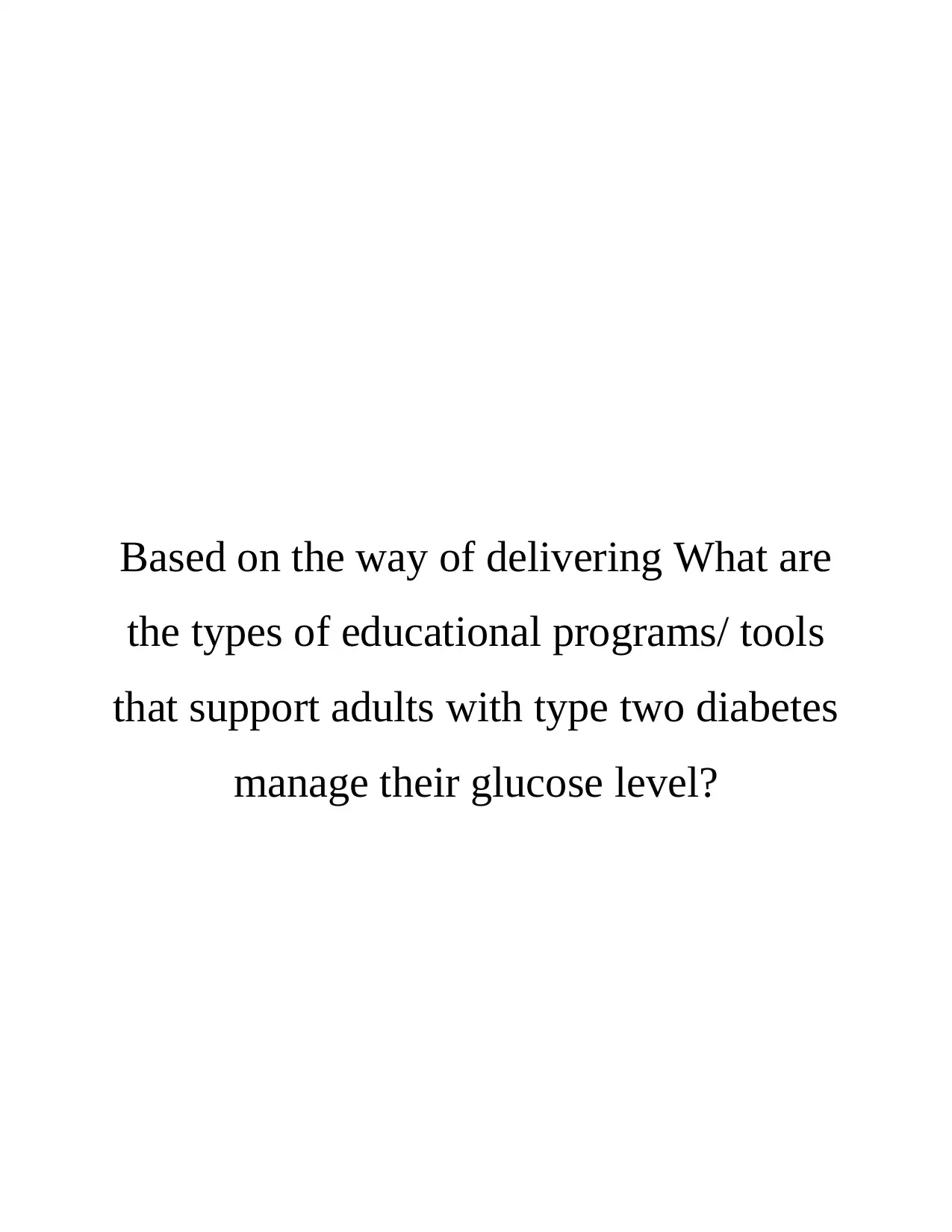
Based on the way of delivering What are
the types of educational programs/ tools
that support adults with type two diabetes
manage their glucose level?
the types of educational programs/ tools
that support adults with type two diabetes
manage their glucose level?
Secure Best Marks with AI Grader
Need help grading? Try our AI Grader for instant feedback on your assignments.
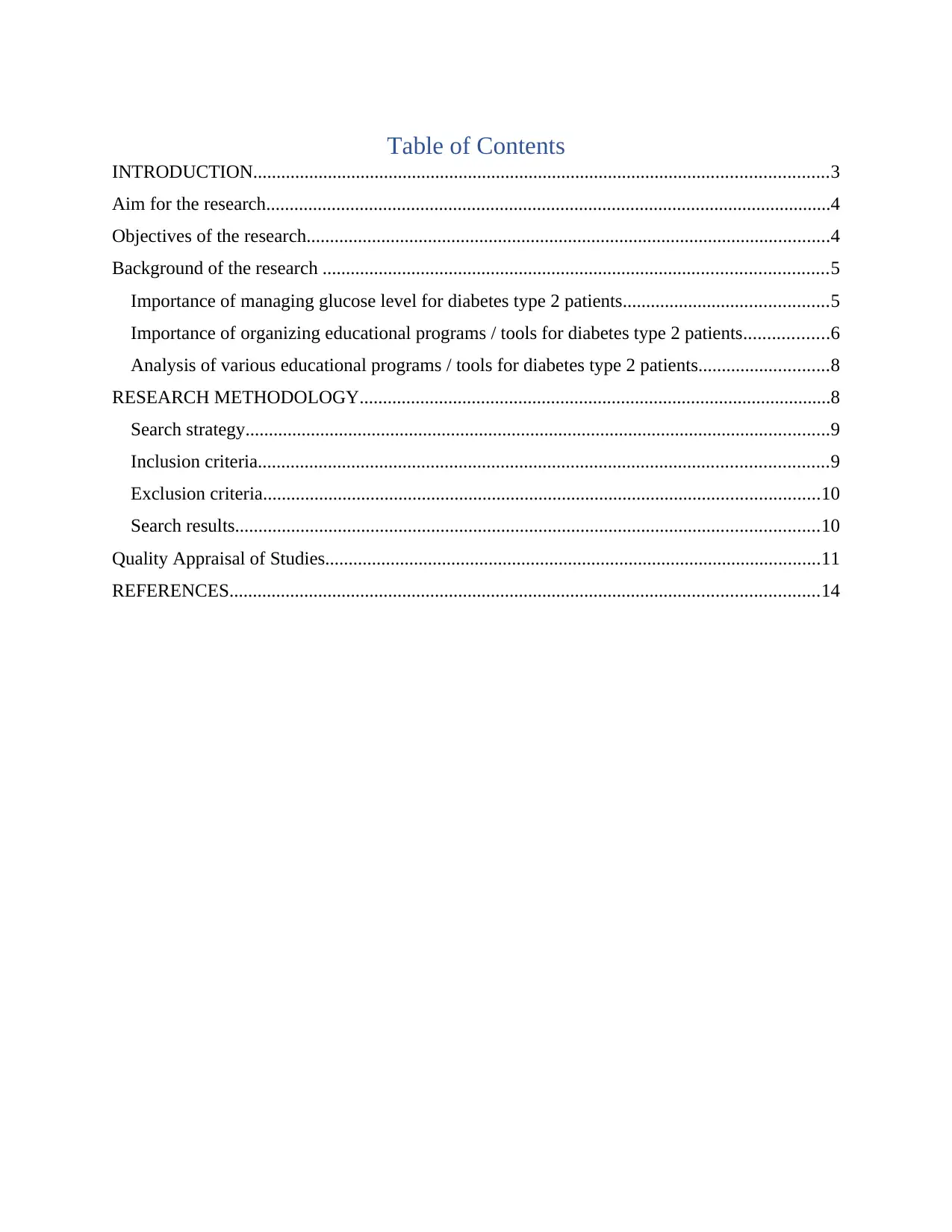
Table of Contents
INTRODUCTION...........................................................................................................................3
Aim for the research.........................................................................................................................4
Objectives of the research................................................................................................................4
Background of the research ............................................................................................................5
Importance of managing glucose level for diabetes type 2 patients............................................5
Importance of organizing educational programs / tools for diabetes type 2 patients..................6
Analysis of various educational programs / tools for diabetes type 2 patients............................8
RESEARCH METHODOLOGY.....................................................................................................8
Search strategy.............................................................................................................................9
Inclusion criteria..........................................................................................................................9
Exclusion criteria.......................................................................................................................10
Search results.............................................................................................................................10
Quality Appraisal of Studies..........................................................................................................11
REFERENCES..............................................................................................................................14
INTRODUCTION...........................................................................................................................3
Aim for the research.........................................................................................................................4
Objectives of the research................................................................................................................4
Background of the research ............................................................................................................5
Importance of managing glucose level for diabetes type 2 patients............................................5
Importance of organizing educational programs / tools for diabetes type 2 patients..................6
Analysis of various educational programs / tools for diabetes type 2 patients............................8
RESEARCH METHODOLOGY.....................................................................................................8
Search strategy.............................................................................................................................9
Inclusion criteria..........................................................................................................................9
Exclusion criteria.......................................................................................................................10
Search results.............................................................................................................................10
Quality Appraisal of Studies..........................................................................................................11
REFERENCES..............................................................................................................................14
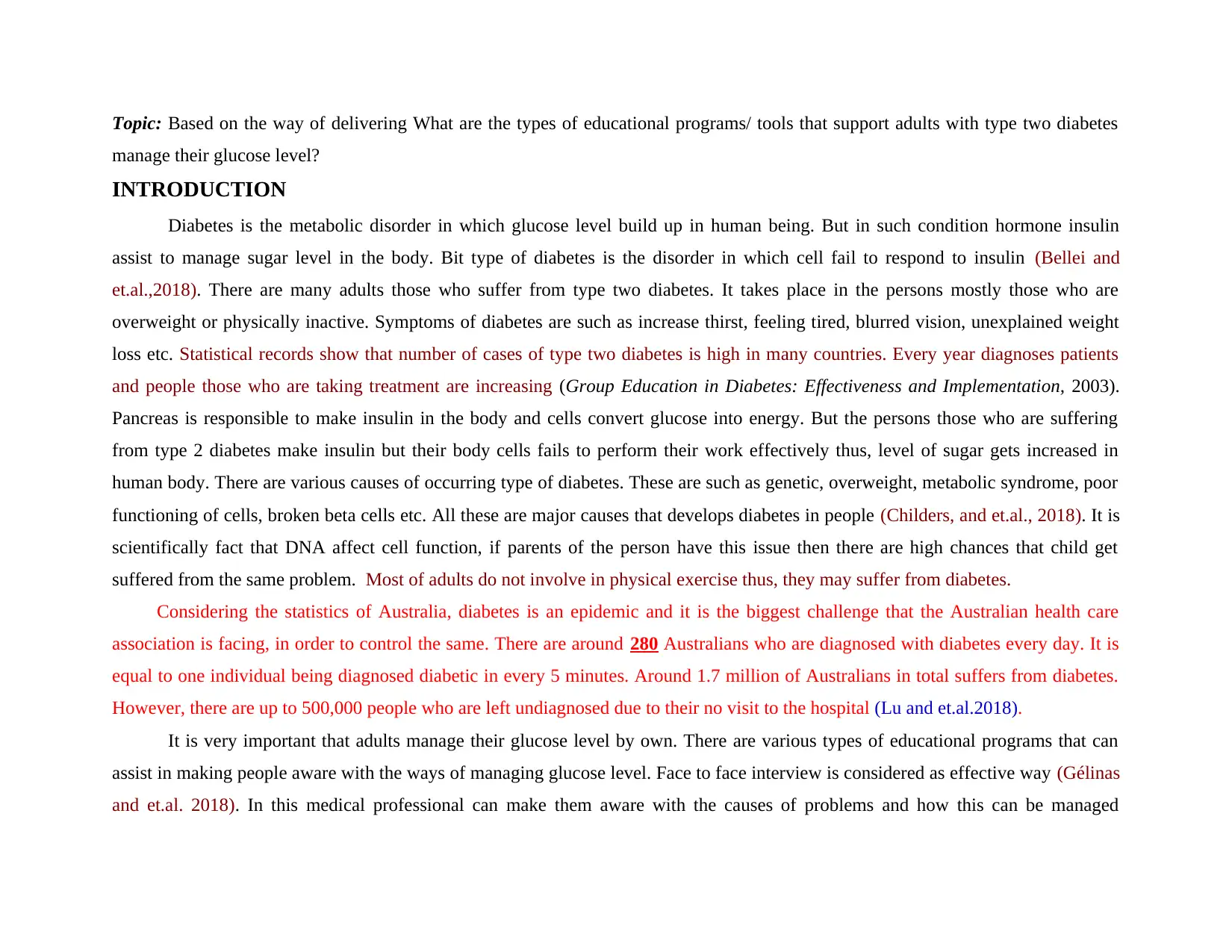
Topic: Based on the way of delivering What are the types of educational programs/ tools that support adults with type two diabetes
manage their glucose level?
INTRODUCTION
Diabetes is the metabolic disorder in which glucose level build up in human being. But in such condition hormone insulin
assist to manage sugar level in the body. Bit type of diabetes is the disorder in which cell fail to respond to insulin (Bellei and
et.al.,2018). There are many adults those who suffer from type two diabetes. It takes place in the persons mostly those who are
overweight or physically inactive. Symptoms of diabetes are such as increase thirst, feeling tired, blurred vision, unexplained weight
loss etc. Statistical records show that number of cases of type two diabetes is high in many countries. Every year diagnoses patients
and people those who are taking treatment are increasing (Group Education in Diabetes: Effectiveness and Implementation, 2003).
Pancreas is responsible to make insulin in the body and cells convert glucose into energy. But the persons those who are suffering
from type 2 diabetes make insulin but their body cells fails to perform their work effectively thus, level of sugar gets increased in
human body. There are various causes of occurring type of diabetes. These are such as genetic, overweight, metabolic syndrome, poor
functioning of cells, broken beta cells etc. All these are major causes that develops diabetes in people (Childers, and et.al., 2018). It is
scientifically fact that DNA affect cell function, if parents of the person have this issue then there are high chances that child get
suffered from the same problem. Most of adults do not involve in physical exercise thus, they may suffer from diabetes.
Considering the statistics of Australia, diabetes is an epidemic and it is the biggest challenge that the Australian health care
association is facing, in order to control the same. There are around 280 Australians who are diagnosed with diabetes every day. It is
equal to one individual being diagnosed diabetic in every 5 minutes. Around 1.7 million of Australians in total suffers from diabetes.
However, there are up to 500,000 people who are left undiagnosed due to their no visit to the hospital (Lu and et.al.2018).
It is very important that adults manage their glucose level by own. There are various types of educational programs that can
assist in making people aware with the ways of managing glucose level. Face to face interview is considered as effective way (Gélinas
and et.al. 2018). In this medical professional can make them aware with the causes of problems and how this can be managed
manage their glucose level?
INTRODUCTION
Diabetes is the metabolic disorder in which glucose level build up in human being. But in such condition hormone insulin
assist to manage sugar level in the body. Bit type of diabetes is the disorder in which cell fail to respond to insulin (Bellei and
et.al.,2018). There are many adults those who suffer from type two diabetes. It takes place in the persons mostly those who are
overweight or physically inactive. Symptoms of diabetes are such as increase thirst, feeling tired, blurred vision, unexplained weight
loss etc. Statistical records show that number of cases of type two diabetes is high in many countries. Every year diagnoses patients
and people those who are taking treatment are increasing (Group Education in Diabetes: Effectiveness and Implementation, 2003).
Pancreas is responsible to make insulin in the body and cells convert glucose into energy. But the persons those who are suffering
from type 2 diabetes make insulin but their body cells fails to perform their work effectively thus, level of sugar gets increased in
human body. There are various causes of occurring type of diabetes. These are such as genetic, overweight, metabolic syndrome, poor
functioning of cells, broken beta cells etc. All these are major causes that develops diabetes in people (Childers, and et.al., 2018). It is
scientifically fact that DNA affect cell function, if parents of the person have this issue then there are high chances that child get
suffered from the same problem. Most of adults do not involve in physical exercise thus, they may suffer from diabetes.
Considering the statistics of Australia, diabetes is an epidemic and it is the biggest challenge that the Australian health care
association is facing, in order to control the same. There are around 280 Australians who are diagnosed with diabetes every day. It is
equal to one individual being diagnosed diabetic in every 5 minutes. Around 1.7 million of Australians in total suffers from diabetes.
However, there are up to 500,000 people who are left undiagnosed due to their no visit to the hospital (Lu and et.al.2018).
It is very important that adults manage their glucose level by own. There are various types of educational programs that can
assist in making people aware with the ways of managing glucose level. Face to face interview is considered as effective way (Gélinas
and et.al. 2018). In this medical professional can make them aware with the causes of problems and how this can be managed
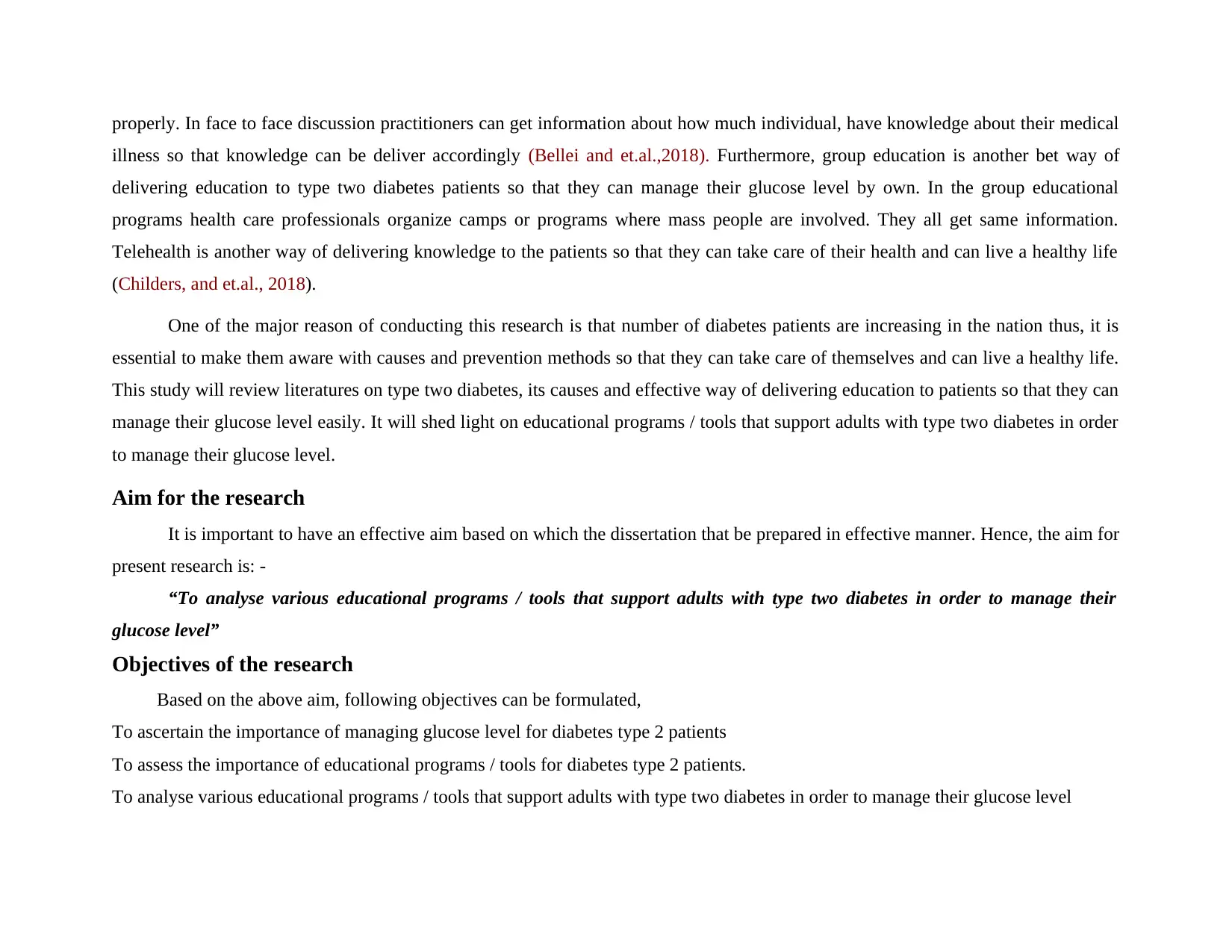
properly. In face to face discussion practitioners can get information about how much individual, have knowledge about their medical
illness so that knowledge can be deliver accordingly (Bellei and et.al.,2018). Furthermore, group education is another bet way of
delivering education to type two diabetes patients so that they can manage their glucose level by own. In the group educational
programs health care professionals organize camps or programs where mass people are involved. They all get same information.
Telehealth is another way of delivering knowledge to the patients so that they can take care of their health and can live a healthy life
(Childers, and et.al., 2018).
One of the major reason of conducting this research is that number of diabetes patients are increasing in the nation thus, it is
essential to make them aware with causes and prevention methods so that they can take care of themselves and can live a healthy life.
This study will review literatures on type two diabetes, its causes and effective way of delivering education to patients so that they can
manage their glucose level easily. It will shed light on educational programs / tools that support adults with type two diabetes in order
to manage their glucose level.
Aim for the research
It is important to have an effective aim based on which the dissertation that be prepared in effective manner. Hence, the aim for
present research is: -
“To analyse various educational programs / tools that support adults with type two diabetes in order to manage their
glucose level”
Objectives of the research
Based on the above aim, following objectives can be formulated,
To ascertain the importance of managing glucose level for diabetes type 2 patients
To assess the importance of educational programs / tools for diabetes type 2 patients.
To analyse various educational programs / tools that support adults with type two diabetes in order to manage their glucose level
illness so that knowledge can be deliver accordingly (Bellei and et.al.,2018). Furthermore, group education is another bet way of
delivering education to type two diabetes patients so that they can manage their glucose level by own. In the group educational
programs health care professionals organize camps or programs where mass people are involved. They all get same information.
Telehealth is another way of delivering knowledge to the patients so that they can take care of their health and can live a healthy life
(Childers, and et.al., 2018).
One of the major reason of conducting this research is that number of diabetes patients are increasing in the nation thus, it is
essential to make them aware with causes and prevention methods so that they can take care of themselves and can live a healthy life.
This study will review literatures on type two diabetes, its causes and effective way of delivering education to patients so that they can
manage their glucose level easily. It will shed light on educational programs / tools that support adults with type two diabetes in order
to manage their glucose level.
Aim for the research
It is important to have an effective aim based on which the dissertation that be prepared in effective manner. Hence, the aim for
present research is: -
“To analyse various educational programs / tools that support adults with type two diabetes in order to manage their
glucose level”
Objectives of the research
Based on the above aim, following objectives can be formulated,
To ascertain the importance of managing glucose level for diabetes type 2 patients
To assess the importance of educational programs / tools for diabetes type 2 patients.
To analyse various educational programs / tools that support adults with type two diabetes in order to manage their glucose level
Secure Best Marks with AI Grader
Need help grading? Try our AI Grader for instant feedback on your assignments.
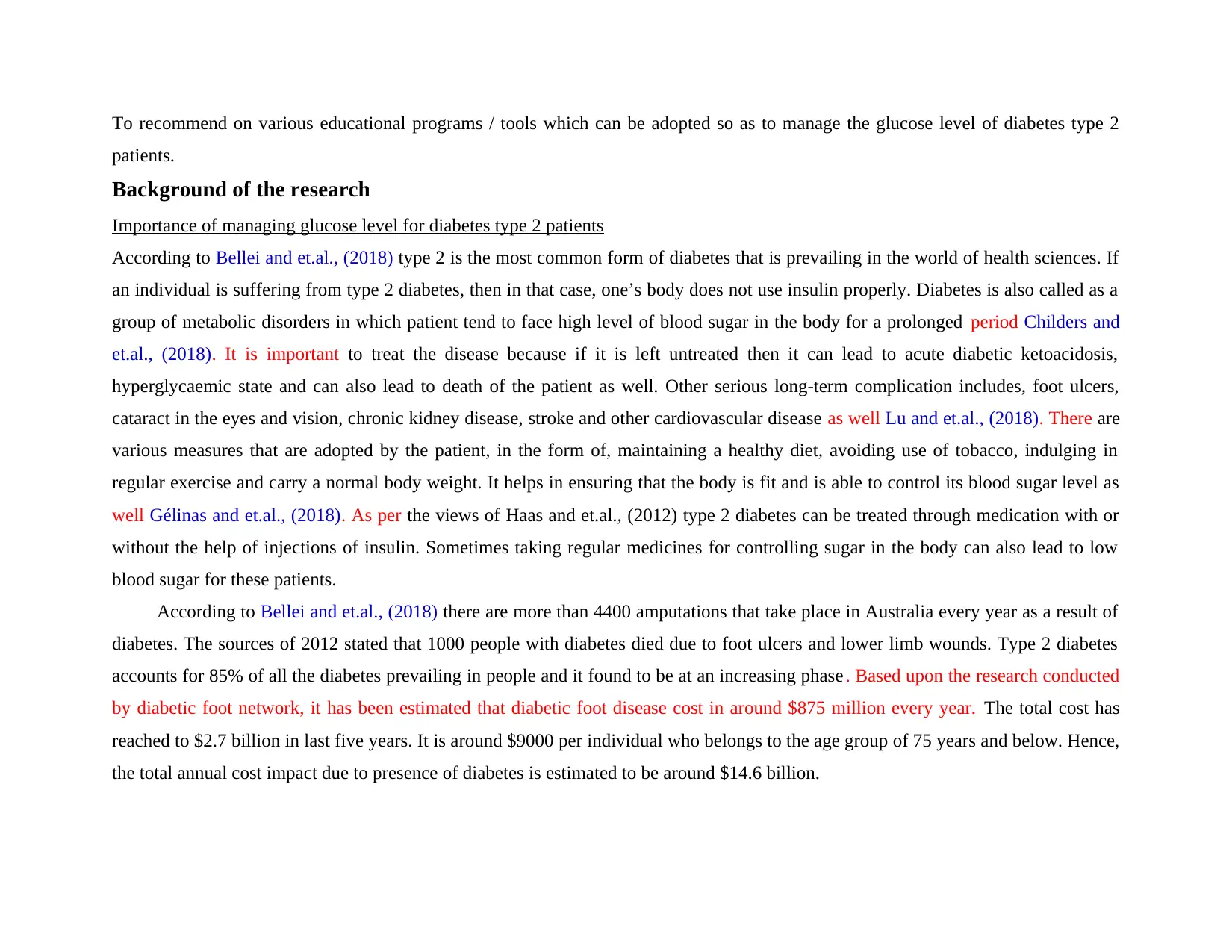
To recommend on various educational programs / tools which can be adopted so as to manage the glucose level of diabetes type 2
patients.
Background of the research
Importance of managing glucose level for diabetes type 2 patients
According to Bellei and et.al., (2018) type 2 is the most common form of diabetes that is prevailing in the world of health sciences. If
an individual is suffering from type 2 diabetes, then in that case, one’s body does not use insulin properly. Diabetes is also called as a
group of metabolic disorders in which patient tend to face high level of blood sugar in the body for a prolonged period Childers and
et.al., (2018). It is important to treat the disease because if it is left untreated then it can lead to acute diabetic ketoacidosis,
hyperglycaemic state and can also lead to death of the patient as well. Other serious long-term complication includes, foot ulcers,
cataract in the eyes and vision, chronic kidney disease, stroke and other cardiovascular disease as well Lu and et.al., (2018). There are
various measures that are adopted by the patient, in the form of, maintaining a healthy diet, avoiding use of tobacco, indulging in
regular exercise and carry a normal body weight. It helps in ensuring that the body is fit and is able to control its blood sugar level as
well Gélinas and et.al., (2018). As per the views of Haas and et.al., (2012) type 2 diabetes can be treated through medication with or
without the help of injections of insulin. Sometimes taking regular medicines for controlling sugar in the body can also lead to low
blood sugar for these patients.
According to Bellei and et.al., (2018) there are more than 4400 amputations that take place in Australia every year as a result of
diabetes. The sources of 2012 stated that 1000 people with diabetes died due to foot ulcers and lower limb wounds. Type 2 diabetes
accounts for 85% of all the diabetes prevailing in people and it found to be at an increasing phase . Based upon the research conducted
by diabetic foot network, it has been estimated that diabetic foot disease cost in around $875 million every year. The total cost has
reached to $2.7 billion in last five years. It is around $9000 per individual who belongs to the age group of 75 years and below. Hence,
the total annual cost impact due to presence of diabetes is estimated to be around $14.6 billion.
patients.
Background of the research
Importance of managing glucose level for diabetes type 2 patients
According to Bellei and et.al., (2018) type 2 is the most common form of diabetes that is prevailing in the world of health sciences. If
an individual is suffering from type 2 diabetes, then in that case, one’s body does not use insulin properly. Diabetes is also called as a
group of metabolic disorders in which patient tend to face high level of blood sugar in the body for a prolonged period Childers and
et.al., (2018). It is important to treat the disease because if it is left untreated then it can lead to acute diabetic ketoacidosis,
hyperglycaemic state and can also lead to death of the patient as well. Other serious long-term complication includes, foot ulcers,
cataract in the eyes and vision, chronic kidney disease, stroke and other cardiovascular disease as well Lu and et.al., (2018). There are
various measures that are adopted by the patient, in the form of, maintaining a healthy diet, avoiding use of tobacco, indulging in
regular exercise and carry a normal body weight. It helps in ensuring that the body is fit and is able to control its blood sugar level as
well Gélinas and et.al., (2018). As per the views of Haas and et.al., (2012) type 2 diabetes can be treated through medication with or
without the help of injections of insulin. Sometimes taking regular medicines for controlling sugar in the body can also lead to low
blood sugar for these patients.
According to Bellei and et.al., (2018) there are more than 4400 amputations that take place in Australia every year as a result of
diabetes. The sources of 2012 stated that 1000 people with diabetes died due to foot ulcers and lower limb wounds. Type 2 diabetes
accounts for 85% of all the diabetes prevailing in people and it found to be at an increasing phase . Based upon the research conducted
by diabetic foot network, it has been estimated that diabetic foot disease cost in around $875 million every year. The total cost has
reached to $2.7 billion in last five years. It is around $9000 per individual who belongs to the age group of 75 years and below. Hence,
the total annual cost impact due to presence of diabetes is estimated to be around $14.6 billion.
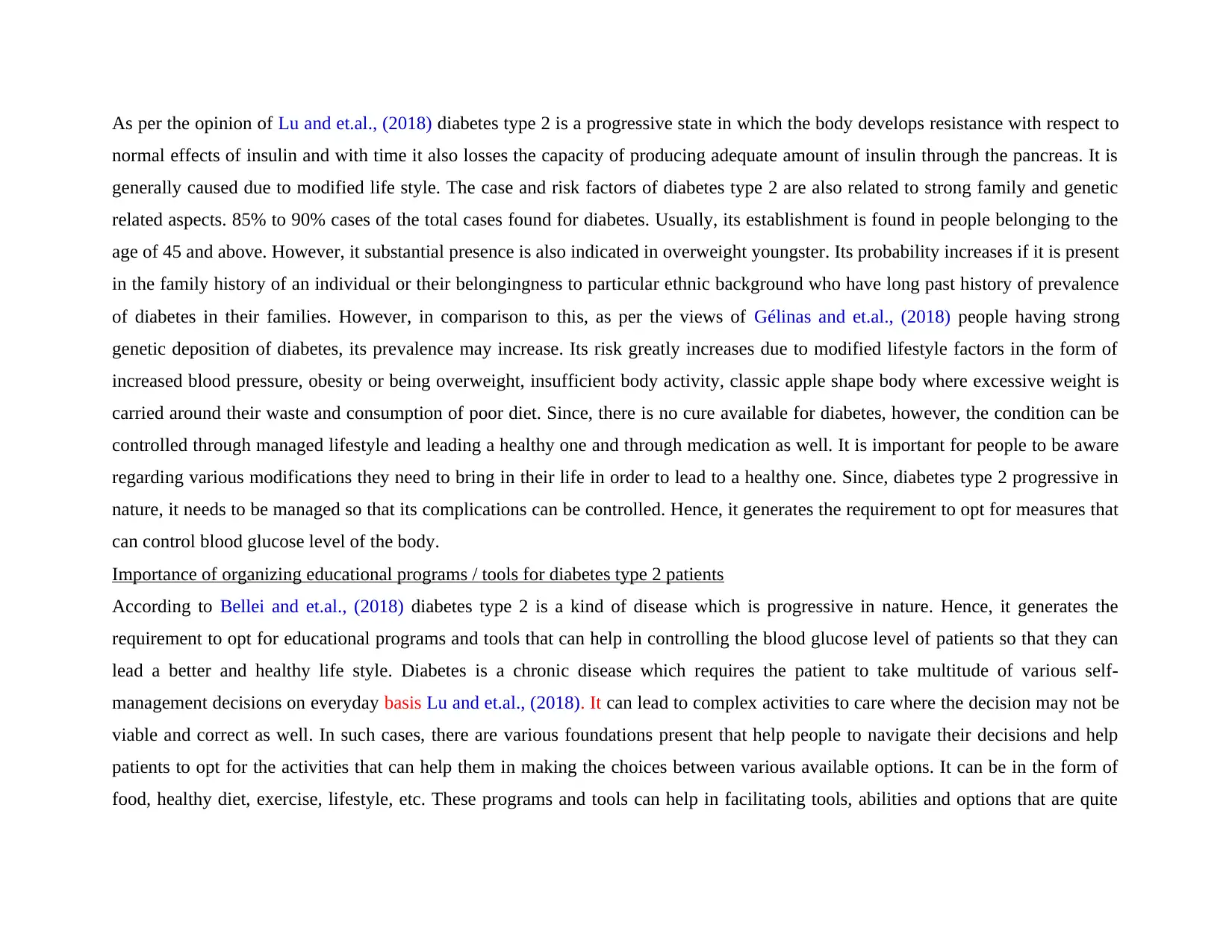
As per the opinion of Lu and et.al., (2018) diabetes type 2 is a progressive state in which the body develops resistance with respect to
normal effects of insulin and with time it also losses the capacity of producing adequate amount of insulin through the pancreas. It is
generally caused due to modified life style. The case and risk factors of diabetes type 2 are also related to strong family and genetic
related aspects. 85% to 90% cases of the total cases found for diabetes. Usually, its establishment is found in people belonging to the
age of 45 and above. However, it substantial presence is also indicated in overweight youngster. Its probability increases if it is present
in the family history of an individual or their belongingness to particular ethnic background who have long past history of prevalence
of diabetes in their families. However, in comparison to this, as per the views of Gélinas and et.al., (2018) people having strong
genetic deposition of diabetes, its prevalence may increase. Its risk greatly increases due to modified lifestyle factors in the form of
increased blood pressure, obesity or being overweight, insufficient body activity, classic apple shape body where excessive weight is
carried around their waste and consumption of poor diet. Since, there is no cure available for diabetes, however, the condition can be
controlled through managed lifestyle and leading a healthy one and through medication as well. It is important for people to be aware
regarding various modifications they need to bring in their life in order to lead to a healthy one. Since, diabetes type 2 progressive in
nature, it needs to be managed so that its complications can be controlled. Hence, it generates the requirement to opt for measures that
can control blood glucose level of the body.
Importance of organizing educational programs / tools for diabetes type 2 patients
According to Bellei and et.al., (2018) diabetes type 2 is a kind of disease which is progressive in nature. Hence, it generates the
requirement to opt for educational programs and tools that can help in controlling the blood glucose level of patients so that they can
lead a better and healthy life style. Diabetes is a chronic disease which requires the patient to take multitude of various self-
management decisions on everyday basis Lu and et.al., (2018). It can lead to complex activities to care where the decision may not be
viable and correct as well. In such cases, there are various foundations present that help people to navigate their decisions and help
patients to opt for the activities that can help them in making the choices between various available options. It can be in the form of
food, healthy diet, exercise, lifestyle, etc. These programs and tools can help in facilitating tools, abilities and options that are quite
normal effects of insulin and with time it also losses the capacity of producing adequate amount of insulin through the pancreas. It is
generally caused due to modified life style. The case and risk factors of diabetes type 2 are also related to strong family and genetic
related aspects. 85% to 90% cases of the total cases found for diabetes. Usually, its establishment is found in people belonging to the
age of 45 and above. However, it substantial presence is also indicated in overweight youngster. Its probability increases if it is present
in the family history of an individual or their belongingness to particular ethnic background who have long past history of prevalence
of diabetes in their families. However, in comparison to this, as per the views of Gélinas and et.al., (2018) people having strong
genetic deposition of diabetes, its prevalence may increase. Its risk greatly increases due to modified lifestyle factors in the form of
increased blood pressure, obesity or being overweight, insufficient body activity, classic apple shape body where excessive weight is
carried around their waste and consumption of poor diet. Since, there is no cure available for diabetes, however, the condition can be
controlled through managed lifestyle and leading a healthy one and through medication as well. It is important for people to be aware
regarding various modifications they need to bring in their life in order to lead to a healthy one. Since, diabetes type 2 progressive in
nature, it needs to be managed so that its complications can be controlled. Hence, it generates the requirement to opt for measures that
can control blood glucose level of the body.
Importance of organizing educational programs / tools for diabetes type 2 patients
According to Bellei and et.al., (2018) diabetes type 2 is a kind of disease which is progressive in nature. Hence, it generates the
requirement to opt for educational programs and tools that can help in controlling the blood glucose level of patients so that they can
lead a better and healthy life style. Diabetes is a chronic disease which requires the patient to take multitude of various self-
management decisions on everyday basis Lu and et.al., (2018). It can lead to complex activities to care where the decision may not be
viable and correct as well. In such cases, there are various foundations present that help people to navigate their decisions and help
patients to opt for the activities that can help them in making the choices between various available options. It can be in the form of
food, healthy diet, exercise, lifestyle, etc. These programs and tools can help in facilitating tools, abilities and options that are quite
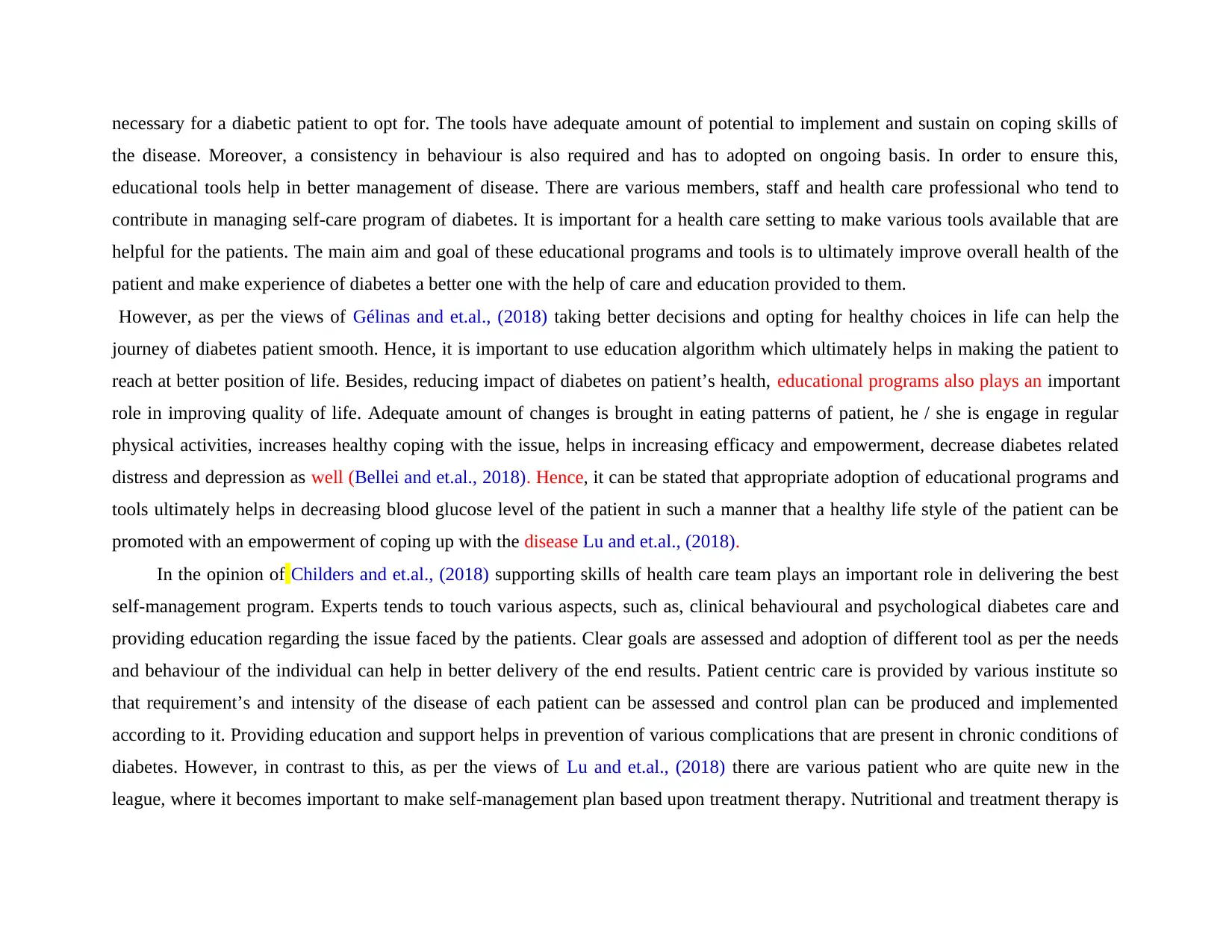
necessary for a diabetic patient to opt for. The tools have adequate amount of potential to implement and sustain on coping skills of
the disease. Moreover, a consistency in behaviour is also required and has to adopted on ongoing basis. In order to ensure this,
educational tools help in better management of disease. There are various members, staff and health care professional who tend to
contribute in managing self-care program of diabetes. It is important for a health care setting to make various tools available that are
helpful for the patients. The main aim and goal of these educational programs and tools is to ultimately improve overall health of the
patient and make experience of diabetes a better one with the help of care and education provided to them.
However, as per the views of Gélinas and et.al., (2018) taking better decisions and opting for healthy choices in life can help the
journey of diabetes patient smooth. Hence, it is important to use education algorithm which ultimately helps in making the patient to
reach at better position of life. Besides, reducing impact of diabetes on patient’s health, educational programs also plays an important
role in improving quality of life. Adequate amount of changes is brought in eating patterns of patient, he / she is engage in regular
physical activities, increases healthy coping with the issue, helps in increasing efficacy and empowerment, decrease diabetes related
distress and depression as well (Bellei and et.al., 2018). Hence, it can be stated that appropriate adoption of educational programs and
tools ultimately helps in decreasing blood glucose level of the patient in such a manner that a healthy life style of the patient can be
promoted with an empowerment of coping up with the disease Lu and et.al., (2018).
In the opinion of Childers and et.al., (2018) supporting skills of health care team plays an important role in delivering the best
self-management program. Experts tends to touch various aspects, such as, clinical behavioural and psychological diabetes care and
providing education regarding the issue faced by the patients. Clear goals are assessed and adoption of different tool as per the needs
and behaviour of the individual can help in better delivery of the end results. Patient centric care is provided by various institute so
that requirement’s and intensity of the disease of each patient can be assessed and control plan can be produced and implemented
according to it. Providing education and support helps in prevention of various complications that are present in chronic conditions of
diabetes. However, in contrast to this, as per the views of Lu and et.al., (2018) there are various patient who are quite new in the
league, where it becomes important to make self-management plan based upon treatment therapy. Nutritional and treatment therapy is
the disease. Moreover, a consistency in behaviour is also required and has to adopted on ongoing basis. In order to ensure this,
educational tools help in better management of disease. There are various members, staff and health care professional who tend to
contribute in managing self-care program of diabetes. It is important for a health care setting to make various tools available that are
helpful for the patients. The main aim and goal of these educational programs and tools is to ultimately improve overall health of the
patient and make experience of diabetes a better one with the help of care and education provided to them.
However, as per the views of Gélinas and et.al., (2018) taking better decisions and opting for healthy choices in life can help the
journey of diabetes patient smooth. Hence, it is important to use education algorithm which ultimately helps in making the patient to
reach at better position of life. Besides, reducing impact of diabetes on patient’s health, educational programs also plays an important
role in improving quality of life. Adequate amount of changes is brought in eating patterns of patient, he / she is engage in regular
physical activities, increases healthy coping with the issue, helps in increasing efficacy and empowerment, decrease diabetes related
distress and depression as well (Bellei and et.al., 2018). Hence, it can be stated that appropriate adoption of educational programs and
tools ultimately helps in decreasing blood glucose level of the patient in such a manner that a healthy life style of the patient can be
promoted with an empowerment of coping up with the disease Lu and et.al., (2018).
In the opinion of Childers and et.al., (2018) supporting skills of health care team plays an important role in delivering the best
self-management program. Experts tends to touch various aspects, such as, clinical behavioural and psychological diabetes care and
providing education regarding the issue faced by the patients. Clear goals are assessed and adoption of different tool as per the needs
and behaviour of the individual can help in better delivery of the end results. Patient centric care is provided by various institute so
that requirement’s and intensity of the disease of each patient can be assessed and control plan can be produced and implemented
according to it. Providing education and support helps in prevention of various complications that are present in chronic conditions of
diabetes. However, in contrast to this, as per the views of Lu and et.al., (2018) there are various patient who are quite new in the
league, where it becomes important to make self-management plan based upon treatment therapy. Nutritional and treatment therapy is
Paraphrase This Document
Need a fresh take? Get an instant paraphrase of this document with our AI Paraphraser
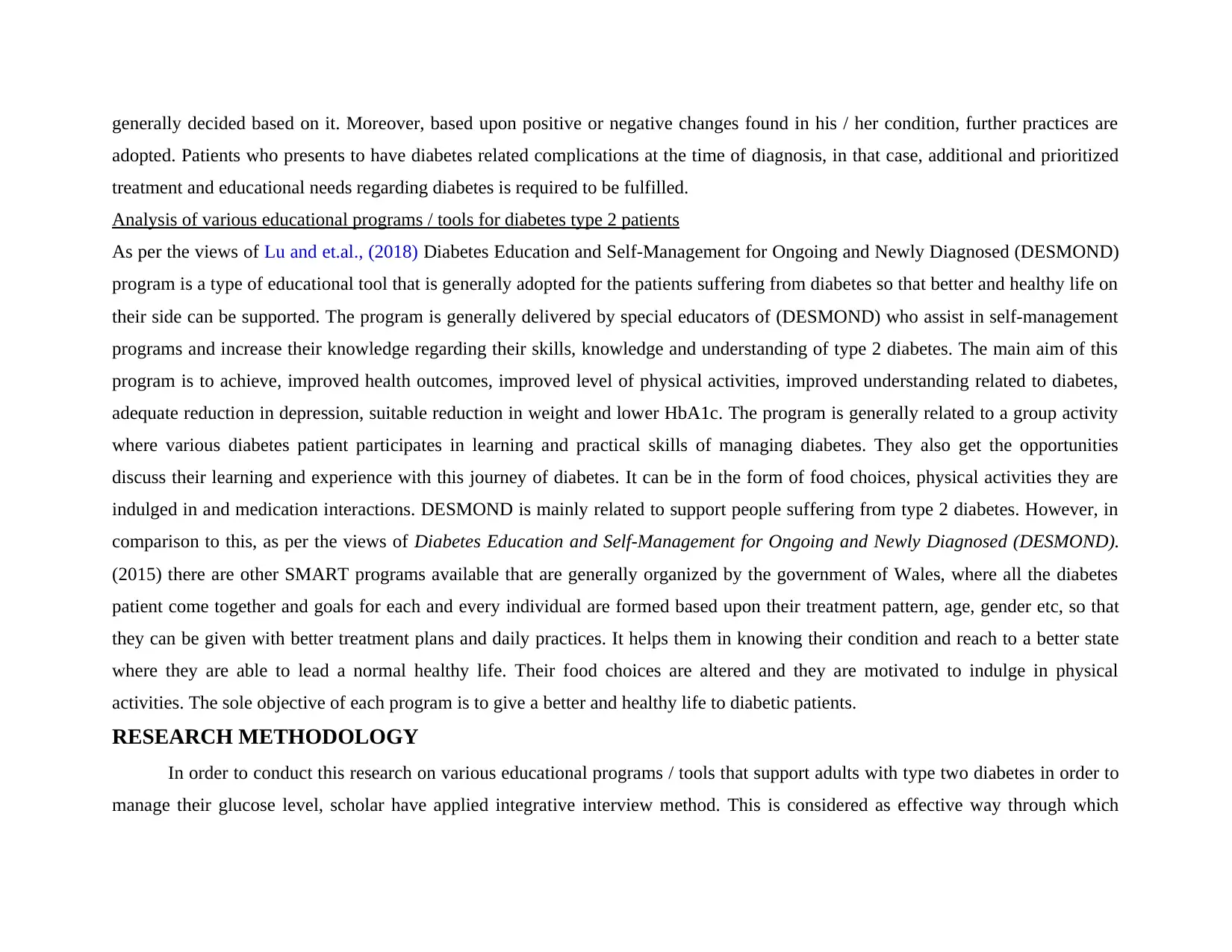
generally decided based on it. Moreover, based upon positive or negative changes found in his / her condition, further practices are
adopted. Patients who presents to have diabetes related complications at the time of diagnosis, in that case, additional and prioritized
treatment and educational needs regarding diabetes is required to be fulfilled.
Analysis of various educational programs / tools for diabetes type 2 patients
As per the views of Lu and et.al., (2018) Diabetes Education and Self-Management for Ongoing and Newly Diagnosed (DESMOND)
program is a type of educational tool that is generally adopted for the patients suffering from diabetes so that better and healthy life on
their side can be supported. The program is generally delivered by special educators of (DESMOND) who assist in self-management
programs and increase their knowledge regarding their skills, knowledge and understanding of type 2 diabetes. The main aim of this
program is to achieve, improved health outcomes, improved level of physical activities, improved understanding related to diabetes,
adequate reduction in depression, suitable reduction in weight and lower HbA1c. The program is generally related to a group activity
where various diabetes patient participates in learning and practical skills of managing diabetes. They also get the opportunities
discuss their learning and experience with this journey of diabetes. It can be in the form of food choices, physical activities they are
indulged in and medication interactions. DESMOND is mainly related to support people suffering from type 2 diabetes. However, in
comparison to this, as per the views of Diabetes Education and Self-Management for Ongoing and Newly Diagnosed (DESMOND).
(2015) there are other SMART programs available that are generally organized by the government of Wales, where all the diabetes
patient come together and goals for each and every individual are formed based upon their treatment pattern, age, gender etc, so that
they can be given with better treatment plans and daily practices. It helps them in knowing their condition and reach to a better state
where they are able to lead a normal healthy life. Their food choices are altered and they are motivated to indulge in physical
activities. The sole objective of each program is to give a better and healthy life to diabetic patients.
RESEARCH METHODOLOGY
In order to conduct this research on various educational programs / tools that support adults with type two diabetes in order to
manage their glucose level, scholar have applied integrative interview method. This is considered as effective way through which
adopted. Patients who presents to have diabetes related complications at the time of diagnosis, in that case, additional and prioritized
treatment and educational needs regarding diabetes is required to be fulfilled.
Analysis of various educational programs / tools for diabetes type 2 patients
As per the views of Lu and et.al., (2018) Diabetes Education and Self-Management for Ongoing and Newly Diagnosed (DESMOND)
program is a type of educational tool that is generally adopted for the patients suffering from diabetes so that better and healthy life on
their side can be supported. The program is generally delivered by special educators of (DESMOND) who assist in self-management
programs and increase their knowledge regarding their skills, knowledge and understanding of type 2 diabetes. The main aim of this
program is to achieve, improved health outcomes, improved level of physical activities, improved understanding related to diabetes,
adequate reduction in depression, suitable reduction in weight and lower HbA1c. The program is generally related to a group activity
where various diabetes patient participates in learning and practical skills of managing diabetes. They also get the opportunities
discuss their learning and experience with this journey of diabetes. It can be in the form of food choices, physical activities they are
indulged in and medication interactions. DESMOND is mainly related to support people suffering from type 2 diabetes. However, in
comparison to this, as per the views of Diabetes Education and Self-Management for Ongoing and Newly Diagnosed (DESMOND).
(2015) there are other SMART programs available that are generally organized by the government of Wales, where all the diabetes
patient come together and goals for each and every individual are formed based upon their treatment pattern, age, gender etc, so that
they can be given with better treatment plans and daily practices. It helps them in knowing their condition and reach to a better state
where they are able to lead a normal healthy life. Their food choices are altered and they are motivated to indulge in physical
activities. The sole objective of each program is to give a better and healthy life to diabetic patients.
RESEARCH METHODOLOGY
In order to conduct this research on various educational programs / tools that support adults with type two diabetes in order to
manage their glucose level, scholar have applied integrative interview method. This is considered as effective way through which
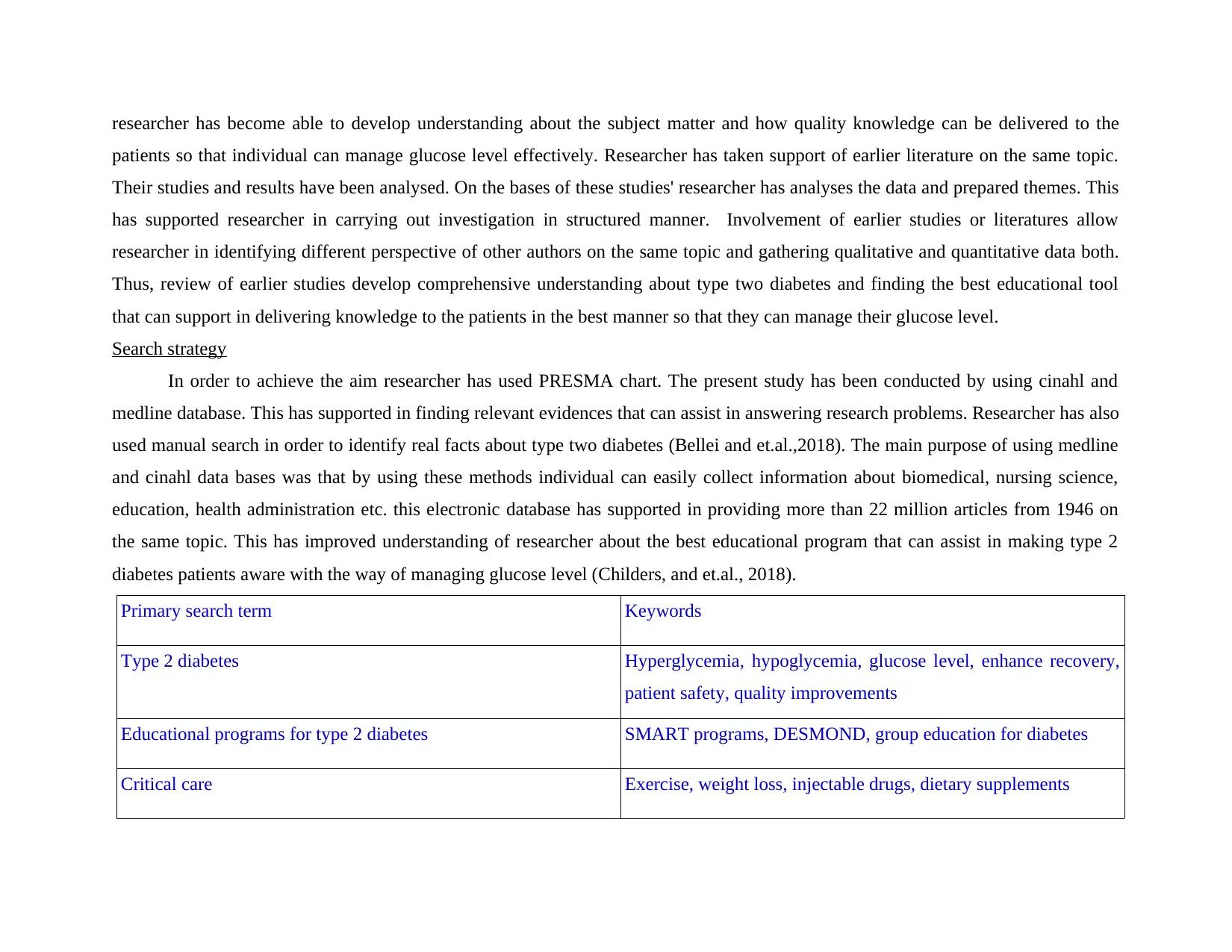
researcher has become able to develop understanding about the subject matter and how quality knowledge can be delivered to the
patients so that individual can manage glucose level effectively. Researcher has taken support of earlier literature on the same topic.
Their studies and results have been analysed. On the bases of these studies' researcher has analyses the data and prepared themes. This
has supported researcher in carrying out investigation in structured manner. Involvement of earlier studies or literatures allow
researcher in identifying different perspective of other authors on the same topic and gathering qualitative and quantitative data both.
Thus, review of earlier studies develop comprehensive understanding about type two diabetes and finding the best educational tool
that can support in delivering knowledge to the patients in the best manner so that they can manage their glucose level.
Search strategy
In order to achieve the aim researcher has used PRESMA chart. The present study has been conducted by using cinahl and
medline database. This has supported in finding relevant evidences that can assist in answering research problems. Researcher has also
used manual search in order to identify real facts about type two diabetes (Bellei and et.al.,2018). The main purpose of using medline
and cinahl data bases was that by using these methods individual can easily collect information about biomedical, nursing science,
education, health administration etc. this electronic database has supported in providing more than 22 million articles from 1946 on
the same topic. This has improved understanding of researcher about the best educational program that can assist in making type 2
diabetes patients aware with the way of managing glucose level (Childers, and et.al., 2018).
Primary search term Keywords
Type 2 diabetes Hyperglycemia, hypoglycemia, glucose level, enhance recovery,
patient safety, quality improvements
Educational programs for type 2 diabetes SMART programs, DESMOND, group education for diabetes
Critical care Exercise, weight loss, injectable drugs, dietary supplements
patients so that individual can manage glucose level effectively. Researcher has taken support of earlier literature on the same topic.
Their studies and results have been analysed. On the bases of these studies' researcher has analyses the data and prepared themes. This
has supported researcher in carrying out investigation in structured manner. Involvement of earlier studies or literatures allow
researcher in identifying different perspective of other authors on the same topic and gathering qualitative and quantitative data both.
Thus, review of earlier studies develop comprehensive understanding about type two diabetes and finding the best educational tool
that can support in delivering knowledge to the patients in the best manner so that they can manage their glucose level.
Search strategy
In order to achieve the aim researcher has used PRESMA chart. The present study has been conducted by using cinahl and
medline database. This has supported in finding relevant evidences that can assist in answering research problems. Researcher has also
used manual search in order to identify real facts about type two diabetes (Bellei and et.al.,2018). The main purpose of using medline
and cinahl data bases was that by using these methods individual can easily collect information about biomedical, nursing science,
education, health administration etc. this electronic database has supported in providing more than 22 million articles from 1946 on
the same topic. This has improved understanding of researcher about the best educational program that can assist in making type 2
diabetes patients aware with the way of managing glucose level (Childers, and et.al., 2018).
Primary search term Keywords
Type 2 diabetes Hyperglycemia, hypoglycemia, glucose level, enhance recovery,
patient safety, quality improvements
Educational programs for type 2 diabetes SMART programs, DESMOND, group education for diabetes
Critical care Exercise, weight loss, injectable drugs, dietary supplements
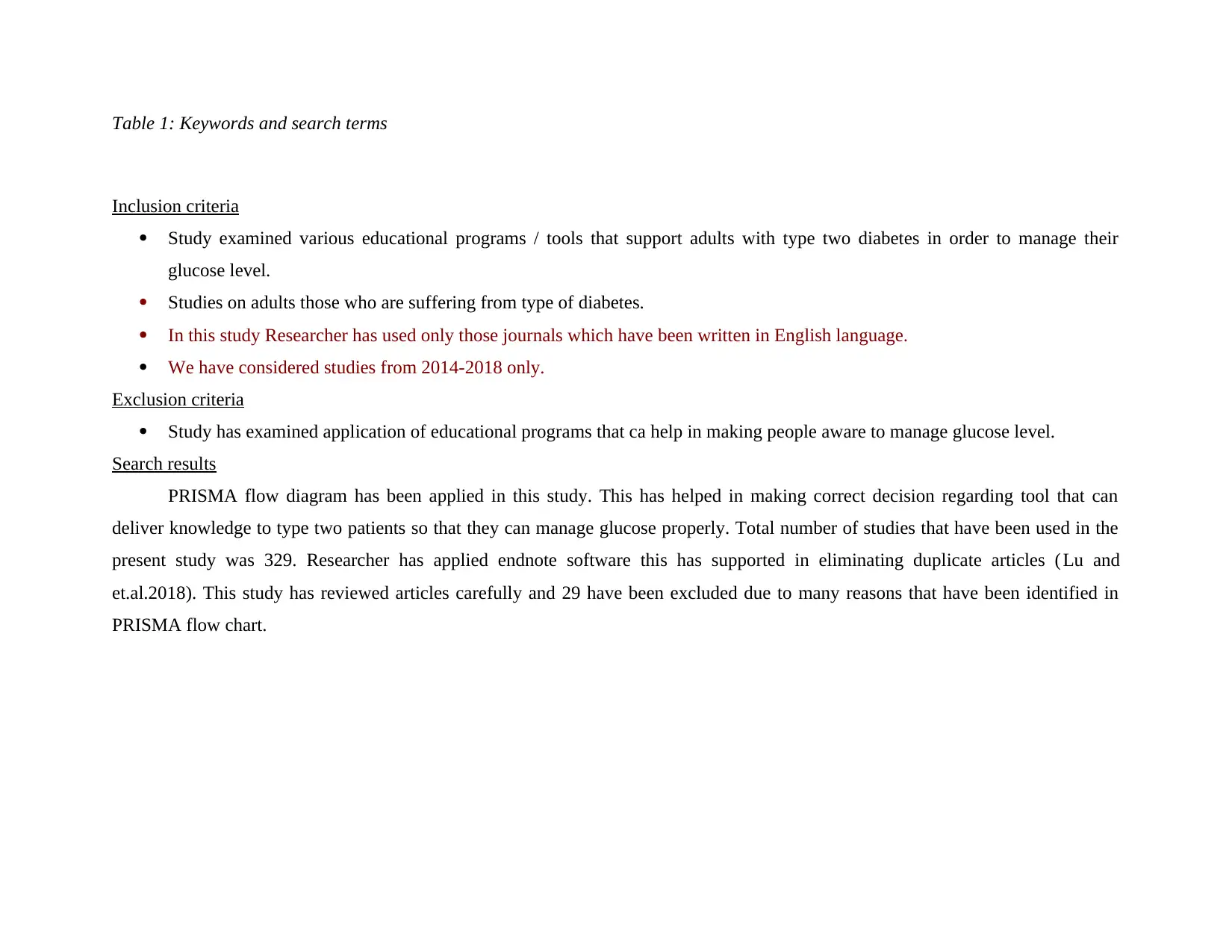
Table 1: Keywords and search terms
Inclusion criteria
Study examined various educational programs / tools that support adults with type two diabetes in order to manage their
glucose level.
Studies on adults those who are suffering from type of diabetes.
In this study Researcher has used only those journals which have been written in English language.
We have considered studies from 2014-2018 only.
Exclusion criteria
Study has examined application of educational programs that ca help in making people aware to manage glucose level.
Search results
PRISMA flow diagram has been applied in this study. This has helped in making correct decision regarding tool that can
deliver knowledge to type two patients so that they can manage glucose properly. Total number of studies that have been used in the
present study was 329. Researcher has applied endnote software this has supported in eliminating duplicate articles ( Lu and
et.al.2018). This study has reviewed articles carefully and 29 have been excluded due to many reasons that have been identified in
PRISMA flow chart.
Inclusion criteria
Study examined various educational programs / tools that support adults with type two diabetes in order to manage their
glucose level.
Studies on adults those who are suffering from type of diabetes.
In this study Researcher has used only those journals which have been written in English language.
We have considered studies from 2014-2018 only.
Exclusion criteria
Study has examined application of educational programs that ca help in making people aware to manage glucose level.
Search results
PRISMA flow diagram has been applied in this study. This has helped in making correct decision regarding tool that can
deliver knowledge to type two patients so that they can manage glucose properly. Total number of studies that have been used in the
present study was 329. Researcher has applied endnote software this has supported in eliminating duplicate articles ( Lu and
et.al.2018). This study has reviewed articles carefully and 29 have been excluded due to many reasons that have been identified in
PRISMA flow chart.
Secure Best Marks with AI Grader
Need help grading? Try our AI Grader for instant feedback on your assignments.
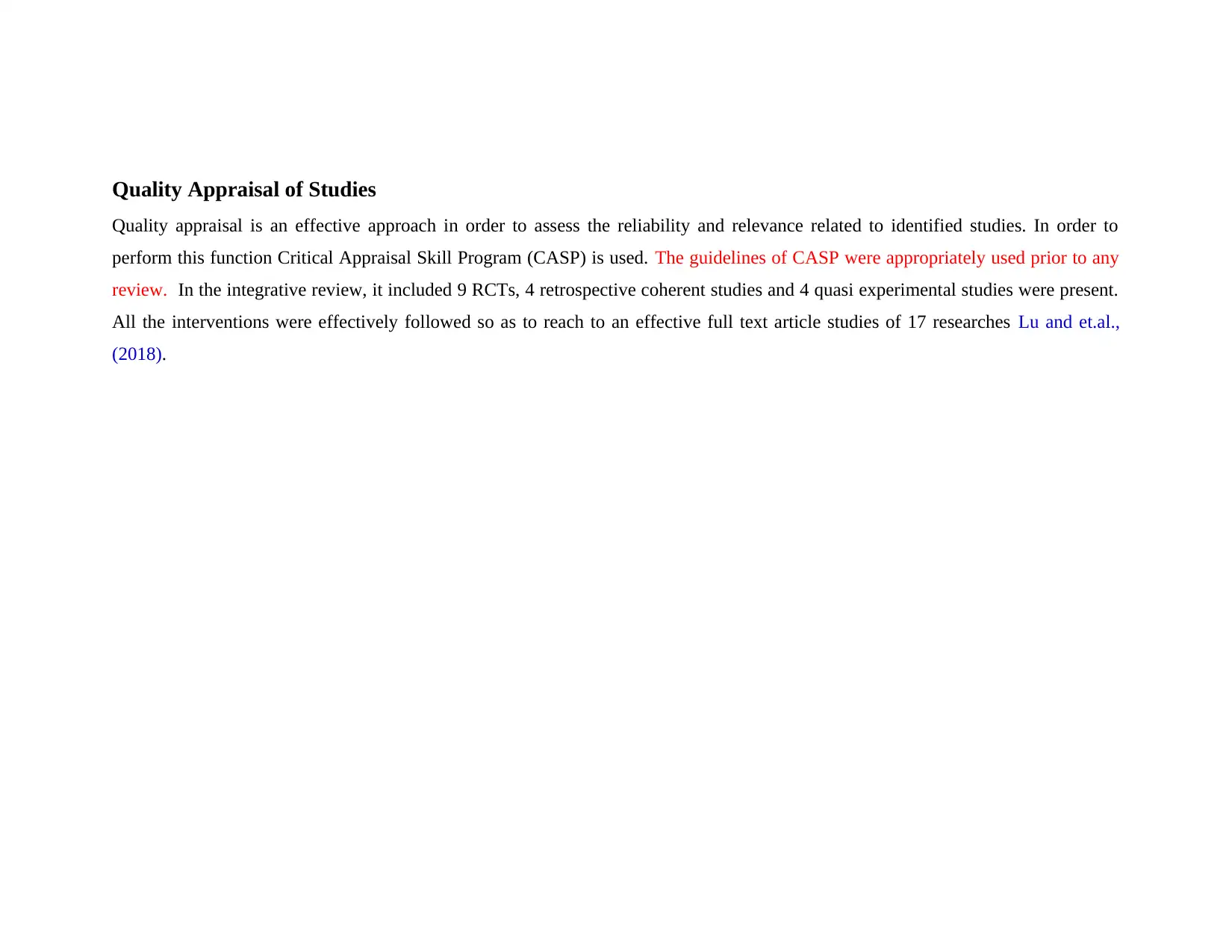
Quality Appraisal of Studies
Quality appraisal is an effective approach in order to assess the reliability and relevance related to identified studies. In order to
perform this function Critical Appraisal Skill Program (CASP) is used. The guidelines of CASP were appropriately used prior to any
review. In the integrative review, it included 9 RCTs, 4 retrospective coherent studies and 4 quasi experimental studies were present.
All the interventions were effectively followed so as to reach to an effective full text article studies of 17 researches Lu and et.al.,
(2018).
Quality appraisal is an effective approach in order to assess the reliability and relevance related to identified studies. In order to
perform this function Critical Appraisal Skill Program (CASP) is used. The guidelines of CASP were appropriately used prior to any
review. In the integrative review, it included 9 RCTs, 4 retrospective coherent studies and 4 quasi experimental studies were present.
All the interventions were effectively followed so as to reach to an effective full text article studies of 17 researches Lu and et.al.,
(2018).
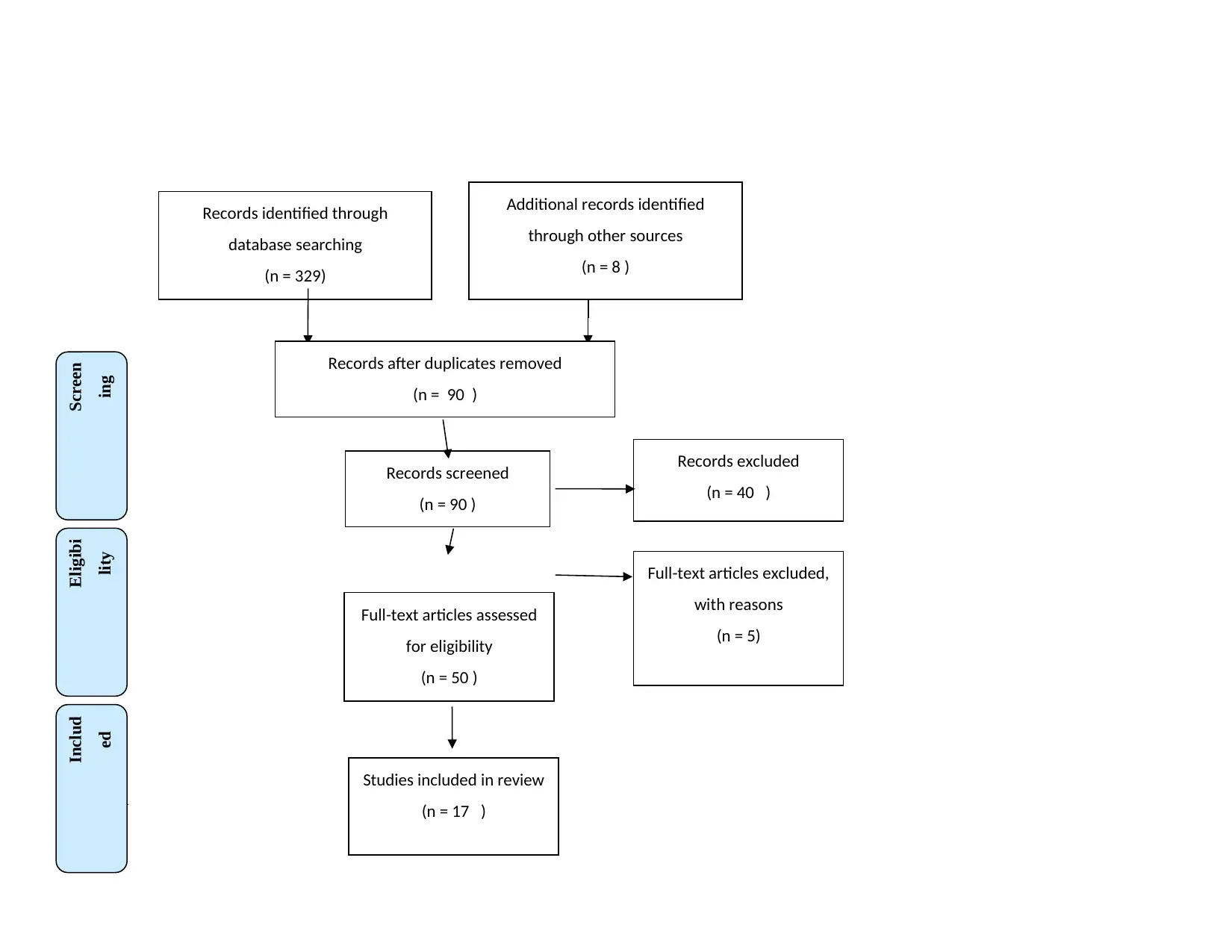
Fi
Records identified through
database searching
(n = 329)
Screen
ing
Includ
ed
Eligibi
lity
Additional records identified
through other sources
(n = 8 )
Records after duplicates removed
(n = 90 )
Records screened
(n = 90 )
Records excluded
(n = 40 )
Full-text articles assessed
for eligibility
(n = 50 )
Full-text articles excluded,
with reasons
(n = 5)
Studies included in review
(n = 17 )
Records identified through
database searching
(n = 329)
Screen
ing
Includ
ed
Eligibi
lity
Additional records identified
through other sources
(n = 8 )
Records after duplicates removed
(n = 90 )
Records screened
(n = 90 )
Records excluded
(n = 40 )
Full-text articles assessed
for eligibility
(n = 50 )
Full-text articles excluded,
with reasons
(n = 5)
Studies included in review
(n = 17 )

Endnote Library
Author Study Aim Method Population Results
Author Study Aim Method Population Results
Paraphrase This Document
Need a fresh take? Get an instant paraphrase of this document with our AI Paraphraser
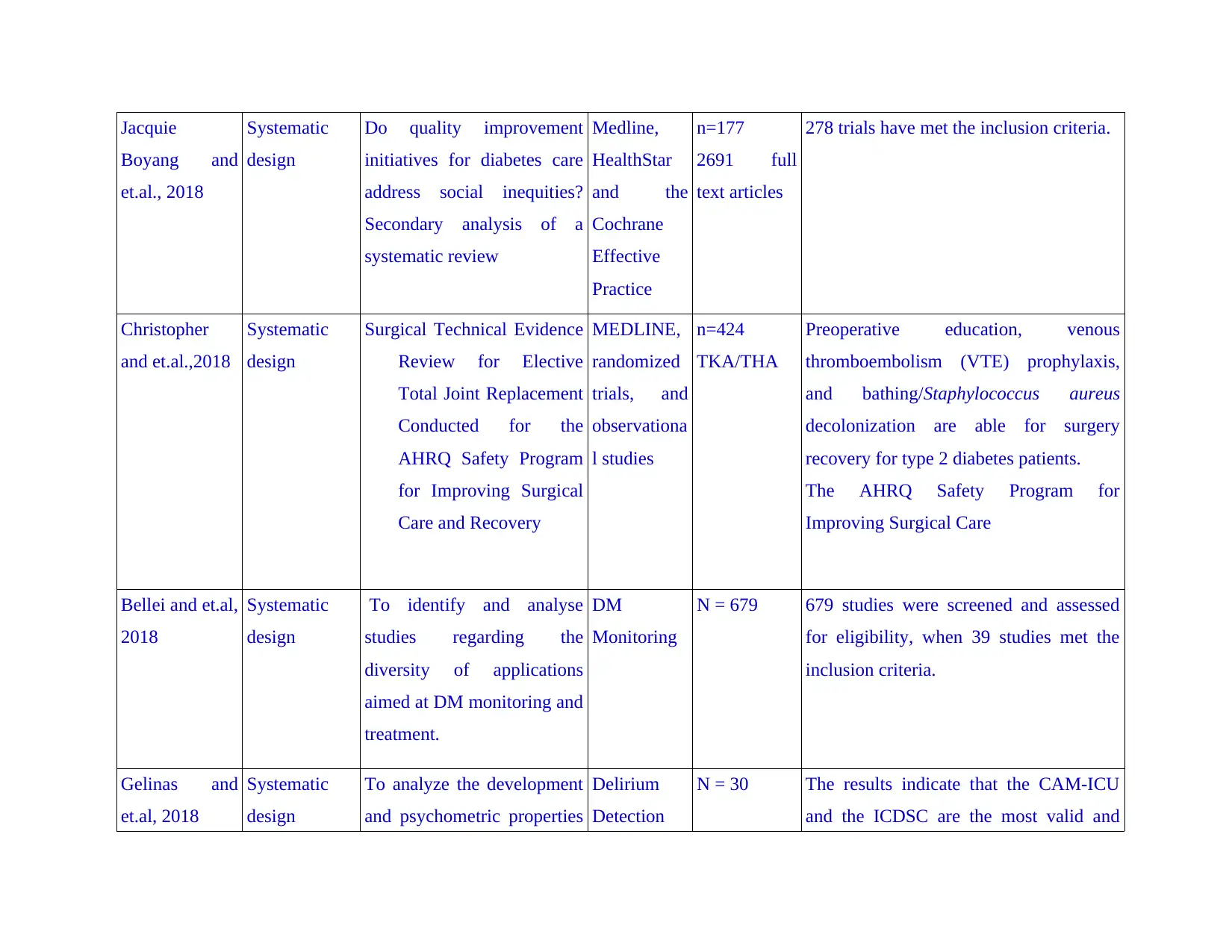
Jacquie
Boyang and
et.al., 2018
Systematic
design
Do quality improvement
initiatives for diabetes care
address social inequities?
Secondary analysis of a
systematic review
Medline,
HealthStar
and the
Cochrane
Effective
Practice
n=177
2691 full
text articles
278 trials have met the inclusion criteria.
Christopher
and et.al.,2018
Systematic
design
Surgical Technical Evidence
Review for Elective
Total Joint Replacement
Conducted for the
AHRQ Safety Program
for Improving Surgical
Care and Recovery
MEDLINE,
randomized
trials, and
observationa
l studies
n=424
TKA/THA
Preoperative education, venous
thromboembolism (VTE) prophylaxis,
and bathing/Staphylococcus aureus
decolonization are able for surgery
recovery for type 2 diabetes patients.
The AHRQ Safety Program for
Improving Surgical Care
Bellei and et.al,
2018
Systematic
design
To identify and analyse
studies regarding the
diversity of applications
aimed at DM monitoring and
treatment.
DM
Monitoring
N = 679 679 studies were screened and assessed
for eligibility, when 39 studies met the
inclusion criteria.
Gelinas and
et.al, 2018
Systematic
design
To analyze the development
and psychometric properties
Delirium
Detection
N = 30 The results indicate that the CAM-ICU
and the ICDSC are the most valid and
Boyang and
et.al., 2018
Systematic
design
Do quality improvement
initiatives for diabetes care
address social inequities?
Secondary analysis of a
systematic review
Medline,
HealthStar
and the
Cochrane
Effective
Practice
n=177
2691 full
text articles
278 trials have met the inclusion criteria.
Christopher
and et.al.,2018
Systematic
design
Surgical Technical Evidence
Review for Elective
Total Joint Replacement
Conducted for the
AHRQ Safety Program
for Improving Surgical
Care and Recovery
MEDLINE,
randomized
trials, and
observationa
l studies
n=424
TKA/THA
Preoperative education, venous
thromboembolism (VTE) prophylaxis,
and bathing/Staphylococcus aureus
decolonization are able for surgery
recovery for type 2 diabetes patients.
The AHRQ Safety Program for
Improving Surgical Care
Bellei and et.al,
2018
Systematic
design
To identify and analyse
studies regarding the
diversity of applications
aimed at DM monitoring and
treatment.
DM
Monitoring
N = 679 679 studies were screened and assessed
for eligibility, when 39 studies met the
inclusion criteria.
Gelinas and
et.al, 2018
Systematic
design
To analyze the development
and psychometric properties
Delirium
Detection
N = 30 The results indicate that the CAM-ICU
and the ICDSC are the most valid and
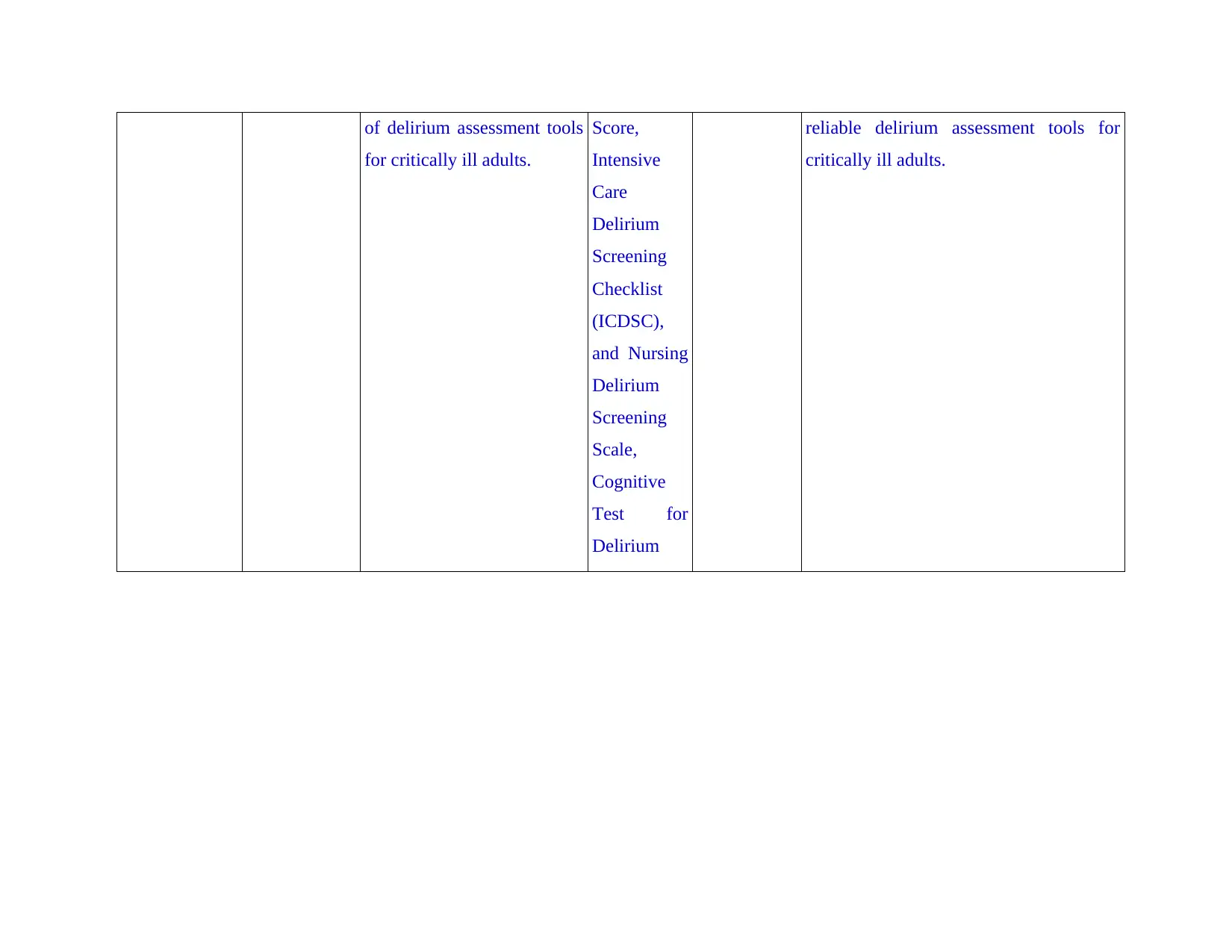
of delirium assessment tools
for critically ill adults.
Score,
Intensive
Care
Delirium
Screening
Checklist
(ICDSC),
and Nursing
Delirium
Screening
Scale,
Cognitive
Test for
Delirium
reliable delirium assessment tools for
critically ill adults.
for critically ill adults.
Score,
Intensive
Care
Delirium
Screening
Checklist
(ICDSC),
and Nursing
Delirium
Screening
Scale,
Cognitive
Test for
Delirium
reliable delirium assessment tools for
critically ill adults.
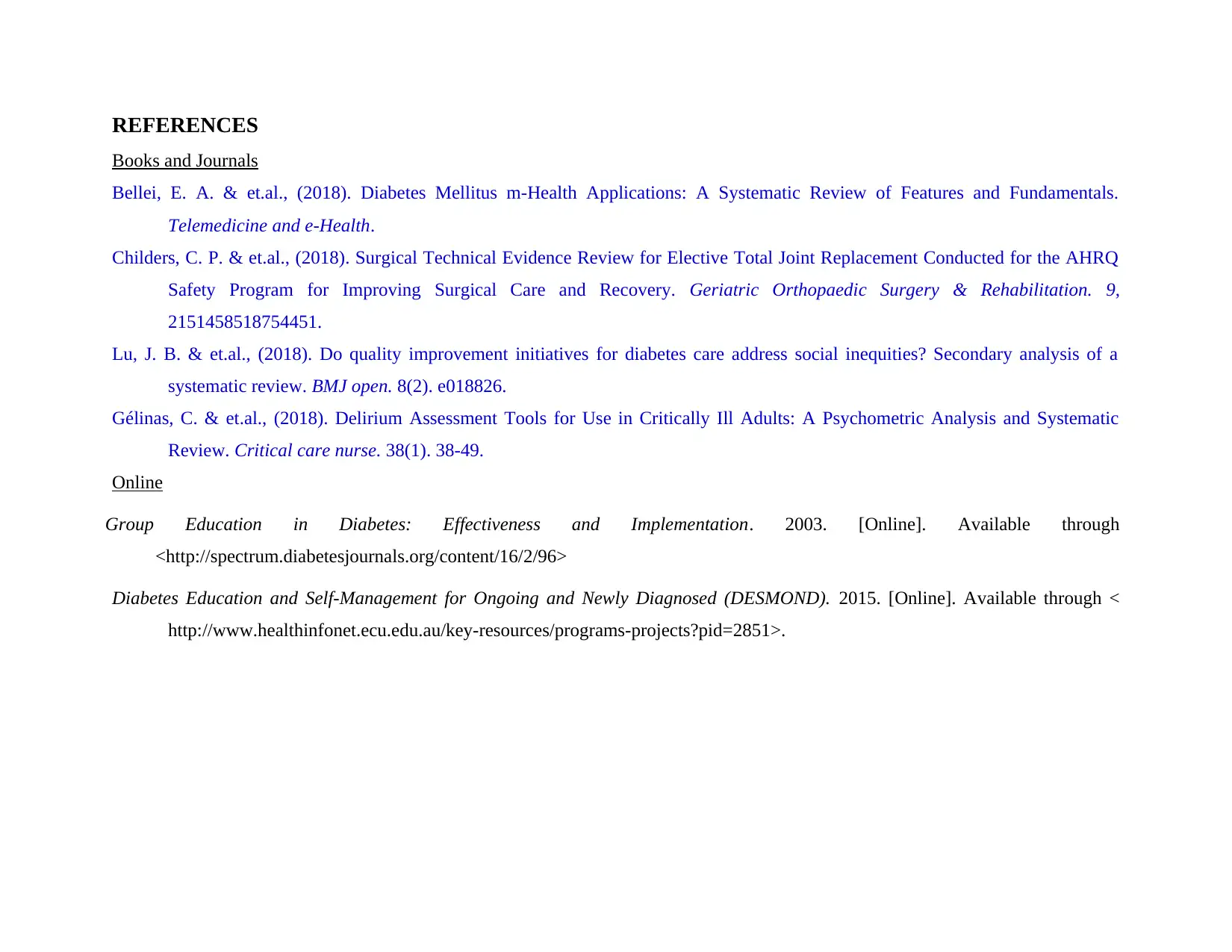
REFERENCES
Books and Journals
Bellei, E. A. & et.al., (2018). Diabetes Mellitus m-Health Applications: A Systematic Review of Features and Fundamentals.
Telemedicine and e-Health.
Childers, C. P. & et.al., (2018). Surgical Technical Evidence Review for Elective Total Joint Replacement Conducted for the AHRQ
Safety Program for Improving Surgical Care and Recovery. Geriatric Orthopaedic Surgery & Rehabilitation. 9,
2151458518754451.
Lu, J. B. & et.al., (2018). Do quality improvement initiatives for diabetes care address social inequities? Secondary analysis of a
systematic review. BMJ open. 8(2). e018826.
Gélinas, C. & et.al., (2018). Delirium Assessment Tools for Use in Critically Ill Adults: A Psychometric Analysis and Systematic
Review. Critical care nurse. 38(1). 38-49.
Online
Group Education in Diabetes: Effectiveness and Implementation. 2003. [Online]. Available through
<http://spectrum.diabetesjournals.org/content/16/2/96>
Diabetes Education and Self-Management for Ongoing and Newly Diagnosed (DESMOND). 2015. [Online]. Available through <
http://www.healthinfonet.ecu.edu.au/key-resources/programs-projects?pid=2851>.
Books and Journals
Bellei, E. A. & et.al., (2018). Diabetes Mellitus m-Health Applications: A Systematic Review of Features and Fundamentals.
Telemedicine and e-Health.
Childers, C. P. & et.al., (2018). Surgical Technical Evidence Review for Elective Total Joint Replacement Conducted for the AHRQ
Safety Program for Improving Surgical Care and Recovery. Geriatric Orthopaedic Surgery & Rehabilitation. 9,
2151458518754451.
Lu, J. B. & et.al., (2018). Do quality improvement initiatives for diabetes care address social inequities? Secondary analysis of a
systematic review. BMJ open. 8(2). e018826.
Gélinas, C. & et.al., (2018). Delirium Assessment Tools for Use in Critically Ill Adults: A Psychometric Analysis and Systematic
Review. Critical care nurse. 38(1). 38-49.
Online
Group Education in Diabetes: Effectiveness and Implementation. 2003. [Online]. Available through
<http://spectrum.diabetesjournals.org/content/16/2/96>
Diabetes Education and Self-Management for Ongoing and Newly Diagnosed (DESMOND). 2015. [Online]. Available through <
http://www.healthinfonet.ecu.edu.au/key-resources/programs-projects?pid=2851>.
1 out of 16
Related Documents
Your All-in-One AI-Powered Toolkit for Academic Success.
+13062052269
info@desklib.com
Available 24*7 on WhatsApp / Email
![[object Object]](/_next/static/media/star-bottom.7253800d.svg)
Unlock your academic potential
© 2024 | Zucol Services PVT LTD | All rights reserved.





